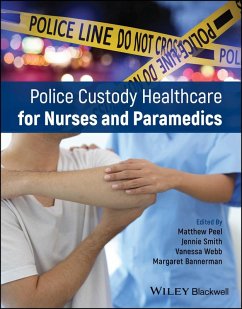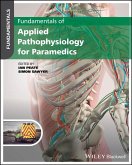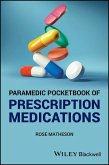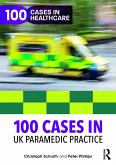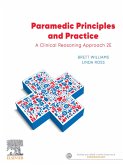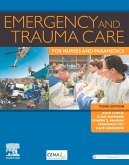Police Custody Healthcare for Nurses and Paramedics (eBook, PDF)
Redaktion: Peel, Matthew; Bannerman, Margaret; Webb, Vanessa; Smith, Jennie
61,99 €
61,99 €
inkl. MwSt.
Sofort per Download lieferbar

0 °P sammeln
61,99 €
Als Download kaufen

61,99 €
inkl. MwSt.
Sofort per Download lieferbar

0 °P sammeln
Jetzt verschenken
Alle Infos zum eBook verschenken
61,99 €
inkl. MwSt.
Sofort per Download lieferbar
Alle Infos zum eBook verschenken

0 °P sammeln
Police Custody Healthcare for Nurses and Paramedics (eBook, PDF)
Redaktion: Peel, Matthew; Bannerman, Margaret; Webb, Vanessa; Smith, Jennie
- Format: PDF
- Merkliste
- Auf die Merkliste
- Bewerten Bewerten
- Teilen
- Produkt teilen
- Produkterinnerung
- Produkterinnerung

Bitte loggen Sie sich zunächst in Ihr Kundenkonto ein oder registrieren Sie sich bei
bücher.de, um das eBook-Abo tolino select nutzen zu können.
Hier können Sie sich einloggen
Hier können Sie sich einloggen
Sie sind bereits eingeloggt. Klicken Sie auf 2. tolino select Abo, um fortzufahren.

Bitte loggen Sie sich zunächst in Ihr Kundenkonto ein oder registrieren Sie sich bei bücher.de, um das eBook-Abo tolino select nutzen zu können.
An essential resource for nurses and paramedics navigating the intricate world of police custody, providing a solid guide for both the novices and the veterans in the field
Across the UK there are on average over 750,000 episodes of police detentions annually, the equivalent of over 2,000 a day. Each one is entitled to healthcare comparable to the wider community. It is estimated on average 54% of these detained individuals are referred to a healthcare professional because of a complex mix of physical health, mental health, medication, substance misuse or social issues. Healthcare…mehr
- Geräte: PC
- mit Kopierschutz
- eBook Hilfe
- Größe: 10.16MB
Andere Kunden interessierten sich auch für
![Police Custody Healthcare for Nurses and Paramedics (eBook, ePUB) Police Custody Healthcare for Nurses and Paramedics (eBook, ePUB)]() Police Custody Healthcare for Nurses and Paramedics (eBook, ePUB)61,99 €
Police Custody Healthcare for Nurses and Paramedics (eBook, ePUB)61,99 €![Fundamentals of Applied Pathophysiology for Paramedics (eBook, PDF) Fundamentals of Applied Pathophysiology for Paramedics (eBook, PDF)]() Fundamentals of Applied Pathophysiology for Paramedics (eBook, PDF)37,99 €
Fundamentals of Applied Pathophysiology for Paramedics (eBook, PDF)37,99 €![Paramedic Pocketbook of Prescription Medications (eBook, PDF) Paramedic Pocketbook of Prescription Medications (eBook, PDF)]() Rose MathesonParamedic Pocketbook of Prescription Medications (eBook, PDF)17,99 €
Rose MathesonParamedic Pocketbook of Prescription Medications (eBook, PDF)17,99 €![100 Cases in UK Paramedic Practice (eBook, PDF) 100 Cases in UK Paramedic Practice (eBook, PDF)]() Christoph Schroth100 Cases in UK Paramedic Practice (eBook, PDF)37,95 €
Christoph Schroth100 Cases in UK Paramedic Practice (eBook, PDF)37,95 €![Paramedic Principles and Practice eBook (eBook, PDF) Paramedic Principles and Practice eBook (eBook, PDF)]() BHlthSc Williams BAVEdParamedic Principles and Practice eBook (eBook, PDF)61,95 €
BHlthSc Williams BAVEdParamedic Principles and Practice eBook (eBook, PDF)61,95 €![Police Services (eBook, PDF) Police Services (eBook, PDF)]() Police Services (eBook, PDF)57,95 €
Police Services (eBook, PDF)57,95 €![Emergency and Trauma Care for Nurses and Paramedics - eBook (eBook, PDF) Emergency and Trauma Care for Nurses and Paramedics - eBook (eBook, PDF)]() GradDipCritCare Curtis RNEmergency and Trauma Care for Nurses and Paramedics - eBook (eBook, PDF)63,95 €
GradDipCritCare Curtis RNEmergency and Trauma Care for Nurses and Paramedics - eBook (eBook, PDF)63,95 €-
-
-
An essential resource for nurses and paramedics navigating the intricate world of police custody, providing a solid guide for both the novices and the veterans in the field
Across the UK there are on average over 750,000 episodes of police detentions annually, the equivalent of over 2,000 a day. Each one is entitled to healthcare comparable to the wider community. It is estimated on average 54% of these detained individuals are referred to a healthcare professional because of a complex mix of physical health, mental health, medication, substance misuse or social issues. Healthcare professionals working in custody must navigate this complex mix while working within a short-term detention setting.
Police Custody Healthcare for Nurses and Paramedics offers a thorough, accessible introduction to this subject and its key aspects. Nurses and paramedics working in police custody healthcare settings will find a volume that addresses their specific needs, with guidelines for understanding initial patient contact, potential comorbidity, mental illness, forensic sampling, documenting injuries, writing statements, and much more. Aligned to the UK Association of Forensic Nurses and Paramedics' Advanced Standards in Education and Training (ASET), this is a must-have resource for professionals in this growing area of practice.
Readers will also find:
Police Custody Healthcare for Nurses and Paramedics is ideal for trainee or registered nurses and paramedics working in police custody healthcare settings or other detention settings.
Across the UK there are on average over 750,000 episodes of police detentions annually, the equivalent of over 2,000 a day. Each one is entitled to healthcare comparable to the wider community. It is estimated on average 54% of these detained individuals are referred to a healthcare professional because of a complex mix of physical health, mental health, medication, substance misuse or social issues. Healthcare professionals working in custody must navigate this complex mix while working within a short-term detention setting.
Police Custody Healthcare for Nurses and Paramedics offers a thorough, accessible introduction to this subject and its key aspects. Nurses and paramedics working in police custody healthcare settings will find a volume that addresses their specific needs, with guidelines for understanding initial patient contact, potential comorbidity, mental illness, forensic sampling, documenting injuries, writing statements, and much more. Aligned to the UK Association of Forensic Nurses and Paramedics' Advanced Standards in Education and Training (ASET), this is a must-have resource for professionals in this growing area of practice.
Readers will also find:
- The first text written specifically for nurses and paramedics by nurses and paramedics with extensive experience in police custody
- Detailed discussion of topics including fitness assessment, medicines management, use of force restraints, and much more
- Pedagogical tools including self-assessment questions, case studies, and learning outcomes
Police Custody Healthcare for Nurses and Paramedics is ideal for trainee or registered nurses and paramedics working in police custody healthcare settings or other detention settings.
Dieser Download kann aus rechtlichen Gründen nur mit Rechnungsadresse in D ausgeliefert werden.
Produktdetails
- Produktdetails
- Verlag: John Wiley & Sons
- Seitenzahl: 275
- Erscheinungstermin: 16. Dezember 2024
- Englisch
- ISBN-13: 9781394204908
- Artikelnr.: 72643518
- Verlag: John Wiley & Sons
- Seitenzahl: 275
- Erscheinungstermin: 16. Dezember 2024
- Englisch
- ISBN-13: 9781394204908
- Artikelnr.: 72643518
- Herstellerkennzeichnung Die Herstellerinformationen sind derzeit nicht verfügbar.
Matthew Peel, RN, QN, MSc, BSc, ASET, V300, is an Advanced Clinical Practitioner in police custody across Yorkshire and Humber, previously seconded to NHS England as the Chief Nursing Officer's Clinical Nurse Fellow leading a national project concerning police custody and sexual assault healthcare. He has over a decade of clinical experience in custody, and has published extensively on related issues of nursing and forensic healthcare. Jennie Smith, RGN, MSc, PGCert, ASET, V300, is President of the UK Association of Forensic Nurses and Paramedics and Clinical Lead for the Merseyside Integrated Police Custody Healthcare and Wider Liaison and Diversion Service. She has over 15 years of clinical experience in custody, and has published and presented extensively on nursing and forensic medicine issues. Vanessa Webb, MBBS, RGN, MSc, BSc, DLM, DFMS, FMERSA, MFMLM, is dual qualified with GMC and NMC registration. As part of her career journey, she was an Advanced Nurse Practitioner, worked in custody and sexual offences for 20 years and as a Senior Leader, Co-Founder and Trustee, has delivered services across the criminal justice system and continues to be passionate about ensuring that we have a caring and competent workforce that is striving to address inequalities for those we serve. Margaret Bannerman, SFHEA, MSc, BSc (Hons), RN, Dip HE, Cert Med Ed, PGCert, RM, is an experienced nurse educator with particular experience in curriculum design, developing bespoke education programmes and competency frameworks. She is also experienced in national standard setting, along with accompanying guidelines and policy documents in the areas of forensic healthcare and sexual health.
List of Contributors xiii
Preface xiv
Acknowledgements xv
About the Companion Website xvii
1 Introduction to Police Custody 1
Matthew Peel, Jennie Smith, Vanessa Webb, and Margaret Bannerman
Introduction 1
Consensus 2
Forensic Healthcare Practitioners 2
About Police Custody Healthcare 4
Detained Individuals 4
Conditions of Detention 4
Those Working in Custody 5
Legislation 6
Consent 8
Confidentiality and Information Sharing 8
Trauma-Informed Care 9
Security 9
Conclusion 10
Learning Activities 11
Resources 11
References 11
Further Reading 11
2 History of Forensic Science 12
Esther McPhail
Introduction 12
Early Evidence of Forensic Science 12
1700s - Advancements in Forensic Science 13
1813 - The Forensic Detection of Arsenic 13
1835 - The First Use of Bullet Comparison 13
1850s - The Use of Anthropometric Data 13
Dr Edmond Locard 14
1900 - Human Blood Groups Identified 15
1937 - The Discovery and Use of Luminol 15
Present Day Forensic Science 15
Conclusion 17
Resources 17
Reference 17
Further Reading 17
3 Fitness Assessments 18
Matthew Peel
Introduction 18
Approach to Fitness Assessments 19
Fitness to Detain 21
Fitness to Interview 23
Fitness to Charge 27
Fitness to Release (Pre-Release Risk Assessment) 28
Fitness to Travel 29
Fitness to Plead 29
Conclusion 29
Learning Activities 29
Resources 29
References 30
Further Reading 30
4 Vulnerability and Appropriate Adults 31
Chris Bath and Roxanna Dehaghani
Introduction 31
Appropriate Adults 31
The Role of an AA 32
Who Can Act as an AA 32
Children and Vulnerable People 33
Healthcare Responsibilities 35
Risks to Justice 36
Research Findings 36
Conclusion 38
Learning Activities 39
Resources 39
References 39
Further Reading 40
5 Managing Long-Term Conditions 41
Vanessa Webb
Introduction 41
Cardiology and Vascular Disease 42
Respiratory Disease 44
Endocrine Disease 46
Gastrointestinal Renal Urology and Gynaecology Disease 49
Neurology 51
Musculo-Skeletal Conditions 53
Infectious Diseases Including Sexual Health 54
Other Considerations 56
Conclusion 57
Learning Activities 57
Resources 58
References 58
Further Reading 58
6 Mental Health 59
Vanessa Webb and Abdulla Kraam
Introduction 59
Assessment 60
Care Planning and Pre-Release Risk Assessment 63
Level of Observations 63
Our Approach 63
Children and Adolescents in Police Custody 64
Common Conditions Seen in Custody 65
Understanding Why People May Not Behave as Expected? 68
Common Treatments for Mental Health 68
Mental Health Legislation 69
Local Pathways for Mental Health 70
Additional Considerations 71
Conclusion 71
Learning Activities 71
Resources 71
References 72
Further Reading 72
7 Medicine Management 73
Vanessa Webb and Dipti Patel
Introduction 73
Medicines Legislation 74
How Patients Can Access Medicines 74
Holistic Assessment 76
How to Manage Patient's Own Medicines 76
PGD's or Prescribing in Custody 77
Management of Controlled Drugs 77
Common Medications Given in Custody 77
Conclusion 79
Learning Activities 80
Resources 80
References 80
Further Reading 80
8 Minor Illness 82
Matthew Peel, Samantha Holmes, and Nick Skinner
Introduction 82
Assessment 82
Toothache 84
Chest Pain 84
Abdominal Pain 84
Dizziness 85
Transient Loss of Consciousness (Collapse) 88
Cold and Flu-like Illnesses (Including Covid-19) 89
Skin Infections 90
Chronic Leg Ulcers 91
Back Pain 91
Drug Reactions 92
Conclusion 93
Learning Activities 93
Resources 93
References 93
Further Reading 93
9 Minor Injuries 94
Jennie Smith
Introduction 94
Assessment 94
Head Injury 95
Cervical Spine Injuries 96
Hand Wrist and Finger Injuries 97
Joint Dislocations 99
Ankle Injuries 100
Tetanus 102
Bite Injuries 103
Wound Care 103
Conclusion 103
Learning Activities 104
Resources 104
References 104
Further Reading 104
10 Substance Use and Misuse 105
Jennie Smith
Introduction 105
Definitions 105
Legislation 106
Drug Classification 107
Intoxication 107
Depressants 109
Opioids 113
Stimulants 115
Cannabinoids 118
Dissociatives 118
Conclusion 118
Learning Activities 119
Resources 119
References 119
11 Use of Force 120
Matthew Peel and Samantha Holmes
Introduction 120
Physical Restraint 121
Leg Restraints 123
Spit Hoods 123
Handcuffs 124
Batons 125
Irritant Sprays 125
Conducted Energy Device (Taser) 126
Dog Bites 129
Attenuating Energy Projectiles (Baton Rounds) 129
Restraint-Related Deaths 131
Conclusion 132
Learning Activities 132
Resources 132
References 132
Further Reading 133
12 Road Traffic Law and Procedures 134
Alex Guymer
Introduction 134
Road Traffic Legislation 135
Aviation Train and Maritime Offences 137
The Healthcare Professional's Role 138
Road Traffic Procedures and Sampling 138
Conclusion 143
Learning Activities 143
Resources 143
References 143
Further Reading 144
13 Evidence Collection (Documenting Injuries and Samples) 145
Esther McPhail
Introduction 145
Documenting Injuries 146
Forensic Samples 155
Conclusion 167
Learning Activities 167
Resources 168
References 168
Further Reading 168
14 Safeguarding 169
Amanda McDonough, Nicola Sheridan, and Mandy Smail
Introduction 169
Safeguarding Children 170
Safeguarding Adults 172
Domestic Violence and Abuse 174
Conclusion 177
Learning Activities 177
Resources 178
References 178
Further Reading 179
15 Writing Statements and Giving Evidence 180
Matthew Peel
Introduction 180
Overview of the Criminal Court Systems 181
Witnesses 182
Statements 183
Attending Court 186
Conclusion 188
Learning Activities 189
Resources 189
References 189
Further Reading 189
16 Special Circumstances 190
Matthew Peel and Thomas Bird
Introduction 191
Terrorism Act 2000 191
Pregnancy 193
Children in Custody 195
Drug Concealment (Packer Stuffer and Pusher) 197
Conclusion 200
Learning Activities 201
Resources 201
References 201
Further Reading 202
17 Governance 203
Vanessa Webb
Introduction 203
The Legislative Standards 203
Regulatory Environment 204
Healthcare Expectations in Police Custody 204
Quality and Safety for Healthcare in Police Custody 204
Introduction to Leadership 209
Conclusion 210
Learning Activities 211
Resources 211
References 211
Further Reading 211
18 Professional Ethics 212
Vanessa Webb
Introduction 212
Introduction to Ethics 213
Introduction to Law 213
Healthcare Law and Ethics and their Interface 214
Consent and the Mental Capacity Act 214
Confidentiality 216
Using a Decision-Making Framework to Support Critical Thinking 217
Acting in an Objective and Impartial Manner 218
Conclusion 219
Learning Activities 219
Resources 219
References 219
Further Reading 220
19 Emergencies 221
Matthew Peel, Nick Hart, and Nick Skinner
Introduction 221
Cardiac Arrest 223
A-B-C-D-E Approach 226
Acute Behavioural Disturbance 229
Alcoholic Ketoacidosis 230
Anaphylaxis 231
Asthma (Acute Exacerbation) 233
Cardiac Chest Pain 233
Delirium Tremens 233
Hypo/Hyperglycaemia 233
Overdose 238
Seizures 239
Sepsis 241
Wernicke's Encephalopathy 243
Deaths in Custody 243
Conclusion 243
Learning Activities 243
Resources 244
References 244
Further Reading 244
Index 245
Preface xiv
Acknowledgements xv
About the Companion Website xvii
1 Introduction to Police Custody 1
Matthew Peel, Jennie Smith, Vanessa Webb, and Margaret Bannerman
Introduction 1
Consensus 2
Forensic Healthcare Practitioners 2
About Police Custody Healthcare 4
Detained Individuals 4
Conditions of Detention 4
Those Working in Custody 5
Legislation 6
Consent 8
Confidentiality and Information Sharing 8
Trauma-Informed Care 9
Security 9
Conclusion 10
Learning Activities 11
Resources 11
References 11
Further Reading 11
2 History of Forensic Science 12
Esther McPhail
Introduction 12
Early Evidence of Forensic Science 12
1700s - Advancements in Forensic Science 13
1813 - The Forensic Detection of Arsenic 13
1835 - The First Use of Bullet Comparison 13
1850s - The Use of Anthropometric Data 13
Dr Edmond Locard 14
1900 - Human Blood Groups Identified 15
1937 - The Discovery and Use of Luminol 15
Present Day Forensic Science 15
Conclusion 17
Resources 17
Reference 17
Further Reading 17
3 Fitness Assessments 18
Matthew Peel
Introduction 18
Approach to Fitness Assessments 19
Fitness to Detain 21
Fitness to Interview 23
Fitness to Charge 27
Fitness to Release (Pre-Release Risk Assessment) 28
Fitness to Travel 29
Fitness to Plead 29
Conclusion 29
Learning Activities 29
Resources 29
References 30
Further Reading 30
4 Vulnerability and Appropriate Adults 31
Chris Bath and Roxanna Dehaghani
Introduction 31
Appropriate Adults 31
The Role of an AA 32
Who Can Act as an AA 32
Children and Vulnerable People 33
Healthcare Responsibilities 35
Risks to Justice 36
Research Findings 36
Conclusion 38
Learning Activities 39
Resources 39
References 39
Further Reading 40
5 Managing Long-Term Conditions 41
Vanessa Webb
Introduction 41
Cardiology and Vascular Disease 42
Respiratory Disease 44
Endocrine Disease 46
Gastrointestinal Renal Urology and Gynaecology Disease 49
Neurology 51
Musculo-Skeletal Conditions 53
Infectious Diseases Including Sexual Health 54
Other Considerations 56
Conclusion 57
Learning Activities 57
Resources 58
References 58
Further Reading 58
6 Mental Health 59
Vanessa Webb and Abdulla Kraam
Introduction 59
Assessment 60
Care Planning and Pre-Release Risk Assessment 63
Level of Observations 63
Our Approach 63
Children and Adolescents in Police Custody 64
Common Conditions Seen in Custody 65
Understanding Why People May Not Behave as Expected? 68
Common Treatments for Mental Health 68
Mental Health Legislation 69
Local Pathways for Mental Health 70
Additional Considerations 71
Conclusion 71
Learning Activities 71
Resources 71
References 72
Further Reading 72
7 Medicine Management 73
Vanessa Webb and Dipti Patel
Introduction 73
Medicines Legislation 74
How Patients Can Access Medicines 74
Holistic Assessment 76
How to Manage Patient's Own Medicines 76
PGD's or Prescribing in Custody 77
Management of Controlled Drugs 77
Common Medications Given in Custody 77
Conclusion 79
Learning Activities 80
Resources 80
References 80
Further Reading 80
8 Minor Illness 82
Matthew Peel, Samantha Holmes, and Nick Skinner
Introduction 82
Assessment 82
Toothache 84
Chest Pain 84
Abdominal Pain 84
Dizziness 85
Transient Loss of Consciousness (Collapse) 88
Cold and Flu-like Illnesses (Including Covid-19) 89
Skin Infections 90
Chronic Leg Ulcers 91
Back Pain 91
Drug Reactions 92
Conclusion 93
Learning Activities 93
Resources 93
References 93
Further Reading 93
9 Minor Injuries 94
Jennie Smith
Introduction 94
Assessment 94
Head Injury 95
Cervical Spine Injuries 96
Hand Wrist and Finger Injuries 97
Joint Dislocations 99
Ankle Injuries 100
Tetanus 102
Bite Injuries 103
Wound Care 103
Conclusion 103
Learning Activities 104
Resources 104
References 104
Further Reading 104
10 Substance Use and Misuse 105
Jennie Smith
Introduction 105
Definitions 105
Legislation 106
Drug Classification 107
Intoxication 107
Depressants 109
Opioids 113
Stimulants 115
Cannabinoids 118
Dissociatives 118
Conclusion 118
Learning Activities 119
Resources 119
References 119
11 Use of Force 120
Matthew Peel and Samantha Holmes
Introduction 120
Physical Restraint 121
Leg Restraints 123
Spit Hoods 123
Handcuffs 124
Batons 125
Irritant Sprays 125
Conducted Energy Device (Taser) 126
Dog Bites 129
Attenuating Energy Projectiles (Baton Rounds) 129
Restraint-Related Deaths 131
Conclusion 132
Learning Activities 132
Resources 132
References 132
Further Reading 133
12 Road Traffic Law and Procedures 134
Alex Guymer
Introduction 134
Road Traffic Legislation 135
Aviation Train and Maritime Offences 137
The Healthcare Professional's Role 138
Road Traffic Procedures and Sampling 138
Conclusion 143
Learning Activities 143
Resources 143
References 143
Further Reading 144
13 Evidence Collection (Documenting Injuries and Samples) 145
Esther McPhail
Introduction 145
Documenting Injuries 146
Forensic Samples 155
Conclusion 167
Learning Activities 167
Resources 168
References 168
Further Reading 168
14 Safeguarding 169
Amanda McDonough, Nicola Sheridan, and Mandy Smail
Introduction 169
Safeguarding Children 170
Safeguarding Adults 172
Domestic Violence and Abuse 174
Conclusion 177
Learning Activities 177
Resources 178
References 178
Further Reading 179
15 Writing Statements and Giving Evidence 180
Matthew Peel
Introduction 180
Overview of the Criminal Court Systems 181
Witnesses 182
Statements 183
Attending Court 186
Conclusion 188
Learning Activities 189
Resources 189
References 189
Further Reading 189
16 Special Circumstances 190
Matthew Peel and Thomas Bird
Introduction 191
Terrorism Act 2000 191
Pregnancy 193
Children in Custody 195
Drug Concealment (Packer Stuffer and Pusher) 197
Conclusion 200
Learning Activities 201
Resources 201
References 201
Further Reading 202
17 Governance 203
Vanessa Webb
Introduction 203
The Legislative Standards 203
Regulatory Environment 204
Healthcare Expectations in Police Custody 204
Quality and Safety for Healthcare in Police Custody 204
Introduction to Leadership 209
Conclusion 210
Learning Activities 211
Resources 211
References 211
Further Reading 211
18 Professional Ethics 212
Vanessa Webb
Introduction 212
Introduction to Ethics 213
Introduction to Law 213
Healthcare Law and Ethics and their Interface 214
Consent and the Mental Capacity Act 214
Confidentiality 216
Using a Decision-Making Framework to Support Critical Thinking 217
Acting in an Objective and Impartial Manner 218
Conclusion 219
Learning Activities 219
Resources 219
References 219
Further Reading 220
19 Emergencies 221
Matthew Peel, Nick Hart, and Nick Skinner
Introduction 221
Cardiac Arrest 223
A-B-C-D-E Approach 226
Acute Behavioural Disturbance 229
Alcoholic Ketoacidosis 230
Anaphylaxis 231
Asthma (Acute Exacerbation) 233
Cardiac Chest Pain 233
Delirium Tremens 233
Hypo/Hyperglycaemia 233
Overdose 238
Seizures 239
Sepsis 241
Wernicke's Encephalopathy 243
Deaths in Custody 243
Conclusion 243
Learning Activities 243
Resources 244
References 244
Further Reading 244
Index 245
List of Contributors xiii
Preface xiv
Acknowledgements xv
About the Companion Website xvii
1 Introduction to Police Custody 1
Matthew Peel, Jennie Smith, Vanessa Webb, and Margaret Bannerman
Introduction 1
Consensus 2
Forensic Healthcare Practitioners 2
About Police Custody Healthcare 4
Detained Individuals 4
Conditions of Detention 4
Those Working in Custody 5
Legislation 6
Consent 8
Confidentiality and Information Sharing 8
Trauma-Informed Care 9
Security 9
Conclusion 10
Learning Activities 11
Resources 11
References 11
Further Reading 11
2 History of Forensic Science 12
Esther McPhail
Introduction 12
Early Evidence of Forensic Science 12
1700s - Advancements in Forensic Science 13
1813 - The Forensic Detection of Arsenic 13
1835 - The First Use of Bullet Comparison 13
1850s - The Use of Anthropometric Data 13
Dr Edmond Locard 14
1900 - Human Blood Groups Identified 15
1937 - The Discovery and Use of Luminol 15
Present Day Forensic Science 15
Conclusion 17
Resources 17
Reference 17
Further Reading 17
3 Fitness Assessments 18
Matthew Peel
Introduction 18
Approach to Fitness Assessments 19
Fitness to Detain 21
Fitness to Interview 23
Fitness to Charge 27
Fitness to Release (Pre-Release Risk Assessment) 28
Fitness to Travel 29
Fitness to Plead 29
Conclusion 29
Learning Activities 29
Resources 29
References 30
Further Reading 30
4 Vulnerability and Appropriate Adults 31
Chris Bath and Roxanna Dehaghani
Introduction 31
Appropriate Adults 31
The Role of an AA 32
Who Can Act as an AA 32
Children and Vulnerable People 33
Healthcare Responsibilities 35
Risks to Justice 36
Research Findings 36
Conclusion 38
Learning Activities 39
Resources 39
References 39
Further Reading 40
5 Managing Long-Term Conditions 41
Vanessa Webb
Introduction 41
Cardiology and Vascular Disease 42
Respiratory Disease 44
Endocrine Disease 46
Gastrointestinal Renal Urology and Gynaecology Disease 49
Neurology 51
Musculo-Skeletal Conditions 53
Infectious Diseases Including Sexual Health 54
Other Considerations 56
Conclusion 57
Learning Activities 57
Resources 58
References 58
Further Reading 58
6 Mental Health 59
Vanessa Webb and Abdulla Kraam
Introduction 59
Assessment 60
Care Planning and Pre-Release Risk Assessment 63
Level of Observations 63
Our Approach 63
Children and Adolescents in Police Custody 64
Common Conditions Seen in Custody 65
Understanding Why People May Not Behave as Expected? 68
Common Treatments for Mental Health 68
Mental Health Legislation 69
Local Pathways for Mental Health 70
Additional Considerations 71
Conclusion 71
Learning Activities 71
Resources 71
References 72
Further Reading 72
7 Medicine Management 73
Vanessa Webb and Dipti Patel
Introduction 73
Medicines Legislation 74
How Patients Can Access Medicines 74
Holistic Assessment 76
How to Manage Patient's Own Medicines 76
PGD's or Prescribing in Custody 77
Management of Controlled Drugs 77
Common Medications Given in Custody 77
Conclusion 79
Learning Activities 80
Resources 80
References 80
Further Reading 80
8 Minor Illness 82
Matthew Peel, Samantha Holmes, and Nick Skinner
Introduction 82
Assessment 82
Toothache 84
Chest Pain 84
Abdominal Pain 84
Dizziness 85
Transient Loss of Consciousness (Collapse) 88
Cold and Flu-like Illnesses (Including Covid-19) 89
Skin Infections 90
Chronic Leg Ulcers 91
Back Pain 91
Drug Reactions 92
Conclusion 93
Learning Activities 93
Resources 93
References 93
Further Reading 93
9 Minor Injuries 94
Jennie Smith
Introduction 94
Assessment 94
Head Injury 95
Cervical Spine Injuries 96
Hand Wrist and Finger Injuries 97
Joint Dislocations 99
Ankle Injuries 100
Tetanus 102
Bite Injuries 103
Wound Care 103
Conclusion 103
Learning Activities 104
Resources 104
References 104
Further Reading 104
10 Substance Use and Misuse 105
Jennie Smith
Introduction 105
Definitions 105
Legislation 106
Drug Classification 107
Intoxication 107
Depressants 109
Opioids 113
Stimulants 115
Cannabinoids 118
Dissociatives 118
Conclusion 118
Learning Activities 119
Resources 119
References 119
11 Use of Force 120
Matthew Peel and Samantha Holmes
Introduction 120
Physical Restraint 121
Leg Restraints 123
Spit Hoods 123
Handcuffs 124
Batons 125
Irritant Sprays 125
Conducted Energy Device (Taser) 126
Dog Bites 129
Attenuating Energy Projectiles (Baton Rounds) 129
Restraint-Related Deaths 131
Conclusion 132
Learning Activities 132
Resources 132
References 132
Further Reading 133
12 Road Traffic Law and Procedures 134
Alex Guymer
Introduction 134
Road Traffic Legislation 135
Aviation Train and Maritime Offences 137
The Healthcare Professional's Role 138
Road Traffic Procedures and Sampling 138
Conclusion 143
Learning Activities 143
Resources 143
References 143
Further Reading 144
13 Evidence Collection (Documenting Injuries and Samples) 145
Esther McPhail
Introduction 145
Documenting Injuries 146
Forensic Samples 155
Conclusion 167
Learning Activities 167
Resources 168
References 168
Further Reading 168
14 Safeguarding 169
Amanda McDonough, Nicola Sheridan, and Mandy Smail
Introduction 169
Safeguarding Children 170
Safeguarding Adults 172
Domestic Violence and Abuse 174
Conclusion 177
Learning Activities 177
Resources 178
References 178
Further Reading 179
15 Writing Statements and Giving Evidence 180
Matthew Peel
Introduction 180
Overview of the Criminal Court Systems 181
Witnesses 182
Statements 183
Attending Court 186
Conclusion 188
Learning Activities 189
Resources 189
References 189
Further Reading 189
16 Special Circumstances 190
Matthew Peel and Thomas Bird
Introduction 191
Terrorism Act 2000 191
Pregnancy 193
Children in Custody 195
Drug Concealment (Packer Stuffer and Pusher) 197
Conclusion 200
Learning Activities 201
Resources 201
References 201
Further Reading 202
17 Governance 203
Vanessa Webb
Introduction 203
The Legislative Standards 203
Regulatory Environment 204
Healthcare Expectations in Police Custody 204
Quality and Safety for Healthcare in Police Custody 204
Introduction to Leadership 209
Conclusion 210
Learning Activities 211
Resources 211
References 211
Further Reading 211
18 Professional Ethics 212
Vanessa Webb
Introduction 212
Introduction to Ethics 213
Introduction to Law 213
Healthcare Law and Ethics and their Interface 214
Consent and the Mental Capacity Act 214
Confidentiality 216
Using a Decision-Making Framework to Support Critical Thinking 217
Acting in an Objective and Impartial Manner 218
Conclusion 219
Learning Activities 219
Resources 219
References 219
Further Reading 220
19 Emergencies 221
Matthew Peel, Nick Hart, and Nick Skinner
Introduction 221
Cardiac Arrest 223
A-B-C-D-E Approach 226
Acute Behavioural Disturbance 229
Alcoholic Ketoacidosis 230
Anaphylaxis 231
Asthma (Acute Exacerbation) 233
Cardiac Chest Pain 233
Delirium Tremens 233
Hypo/Hyperglycaemia 233
Overdose 238
Seizures 239
Sepsis 241
Wernicke's Encephalopathy 243
Deaths in Custody 243
Conclusion 243
Learning Activities 243
Resources 244
References 244
Further Reading 244
Index 245
Preface xiv
Acknowledgements xv
About the Companion Website xvii
1 Introduction to Police Custody 1
Matthew Peel, Jennie Smith, Vanessa Webb, and Margaret Bannerman
Introduction 1
Consensus 2
Forensic Healthcare Practitioners 2
About Police Custody Healthcare 4
Detained Individuals 4
Conditions of Detention 4
Those Working in Custody 5
Legislation 6
Consent 8
Confidentiality and Information Sharing 8
Trauma-Informed Care 9
Security 9
Conclusion 10
Learning Activities 11
Resources 11
References 11
Further Reading 11
2 History of Forensic Science 12
Esther McPhail
Introduction 12
Early Evidence of Forensic Science 12
1700s - Advancements in Forensic Science 13
1813 - The Forensic Detection of Arsenic 13
1835 - The First Use of Bullet Comparison 13
1850s - The Use of Anthropometric Data 13
Dr Edmond Locard 14
1900 - Human Blood Groups Identified 15
1937 - The Discovery and Use of Luminol 15
Present Day Forensic Science 15
Conclusion 17
Resources 17
Reference 17
Further Reading 17
3 Fitness Assessments 18
Matthew Peel
Introduction 18
Approach to Fitness Assessments 19
Fitness to Detain 21
Fitness to Interview 23
Fitness to Charge 27
Fitness to Release (Pre-Release Risk Assessment) 28
Fitness to Travel 29
Fitness to Plead 29
Conclusion 29
Learning Activities 29
Resources 29
References 30
Further Reading 30
4 Vulnerability and Appropriate Adults 31
Chris Bath and Roxanna Dehaghani
Introduction 31
Appropriate Adults 31
The Role of an AA 32
Who Can Act as an AA 32
Children and Vulnerable People 33
Healthcare Responsibilities 35
Risks to Justice 36
Research Findings 36
Conclusion 38
Learning Activities 39
Resources 39
References 39
Further Reading 40
5 Managing Long-Term Conditions 41
Vanessa Webb
Introduction 41
Cardiology and Vascular Disease 42
Respiratory Disease 44
Endocrine Disease 46
Gastrointestinal Renal Urology and Gynaecology Disease 49
Neurology 51
Musculo-Skeletal Conditions 53
Infectious Diseases Including Sexual Health 54
Other Considerations 56
Conclusion 57
Learning Activities 57
Resources 58
References 58
Further Reading 58
6 Mental Health 59
Vanessa Webb and Abdulla Kraam
Introduction 59
Assessment 60
Care Planning and Pre-Release Risk Assessment 63
Level of Observations 63
Our Approach 63
Children and Adolescents in Police Custody 64
Common Conditions Seen in Custody 65
Understanding Why People May Not Behave as Expected? 68
Common Treatments for Mental Health 68
Mental Health Legislation 69
Local Pathways for Mental Health 70
Additional Considerations 71
Conclusion 71
Learning Activities 71
Resources 71
References 72
Further Reading 72
7 Medicine Management 73
Vanessa Webb and Dipti Patel
Introduction 73
Medicines Legislation 74
How Patients Can Access Medicines 74
Holistic Assessment 76
How to Manage Patient's Own Medicines 76
PGD's or Prescribing in Custody 77
Management of Controlled Drugs 77
Common Medications Given in Custody 77
Conclusion 79
Learning Activities 80
Resources 80
References 80
Further Reading 80
8 Minor Illness 82
Matthew Peel, Samantha Holmes, and Nick Skinner
Introduction 82
Assessment 82
Toothache 84
Chest Pain 84
Abdominal Pain 84
Dizziness 85
Transient Loss of Consciousness (Collapse) 88
Cold and Flu-like Illnesses (Including Covid-19) 89
Skin Infections 90
Chronic Leg Ulcers 91
Back Pain 91
Drug Reactions 92
Conclusion 93
Learning Activities 93
Resources 93
References 93
Further Reading 93
9 Minor Injuries 94
Jennie Smith
Introduction 94
Assessment 94
Head Injury 95
Cervical Spine Injuries 96
Hand Wrist and Finger Injuries 97
Joint Dislocations 99
Ankle Injuries 100
Tetanus 102
Bite Injuries 103
Wound Care 103
Conclusion 103
Learning Activities 104
Resources 104
References 104
Further Reading 104
10 Substance Use and Misuse 105
Jennie Smith
Introduction 105
Definitions 105
Legislation 106
Drug Classification 107
Intoxication 107
Depressants 109
Opioids 113
Stimulants 115
Cannabinoids 118
Dissociatives 118
Conclusion 118
Learning Activities 119
Resources 119
References 119
11 Use of Force 120
Matthew Peel and Samantha Holmes
Introduction 120
Physical Restraint 121
Leg Restraints 123
Spit Hoods 123
Handcuffs 124
Batons 125
Irritant Sprays 125
Conducted Energy Device (Taser) 126
Dog Bites 129
Attenuating Energy Projectiles (Baton Rounds) 129
Restraint-Related Deaths 131
Conclusion 132
Learning Activities 132
Resources 132
References 132
Further Reading 133
12 Road Traffic Law and Procedures 134
Alex Guymer
Introduction 134
Road Traffic Legislation 135
Aviation Train and Maritime Offences 137
The Healthcare Professional's Role 138
Road Traffic Procedures and Sampling 138
Conclusion 143
Learning Activities 143
Resources 143
References 143
Further Reading 144
13 Evidence Collection (Documenting Injuries and Samples) 145
Esther McPhail
Introduction 145
Documenting Injuries 146
Forensic Samples 155
Conclusion 167
Learning Activities 167
Resources 168
References 168
Further Reading 168
14 Safeguarding 169
Amanda McDonough, Nicola Sheridan, and Mandy Smail
Introduction 169
Safeguarding Children 170
Safeguarding Adults 172
Domestic Violence and Abuse 174
Conclusion 177
Learning Activities 177
Resources 178
References 178
Further Reading 179
15 Writing Statements and Giving Evidence 180
Matthew Peel
Introduction 180
Overview of the Criminal Court Systems 181
Witnesses 182
Statements 183
Attending Court 186
Conclusion 188
Learning Activities 189
Resources 189
References 189
Further Reading 189
16 Special Circumstances 190
Matthew Peel and Thomas Bird
Introduction 191
Terrorism Act 2000 191
Pregnancy 193
Children in Custody 195
Drug Concealment (Packer Stuffer and Pusher) 197
Conclusion 200
Learning Activities 201
Resources 201
References 201
Further Reading 202
17 Governance 203
Vanessa Webb
Introduction 203
The Legislative Standards 203
Regulatory Environment 204
Healthcare Expectations in Police Custody 204
Quality and Safety for Healthcare in Police Custody 204
Introduction to Leadership 209
Conclusion 210
Learning Activities 211
Resources 211
References 211
Further Reading 211
18 Professional Ethics 212
Vanessa Webb
Introduction 212
Introduction to Ethics 213
Introduction to Law 213
Healthcare Law and Ethics and their Interface 214
Consent and the Mental Capacity Act 214
Confidentiality 216
Using a Decision-Making Framework to Support Critical Thinking 217
Acting in an Objective and Impartial Manner 218
Conclusion 219
Learning Activities 219
Resources 219
References 219
Further Reading 220
19 Emergencies 221
Matthew Peel, Nick Hart, and Nick Skinner
Introduction 221
Cardiac Arrest 223
A-B-C-D-E Approach 226
Acute Behavioural Disturbance 229
Alcoholic Ketoacidosis 230
Anaphylaxis 231
Asthma (Acute Exacerbation) 233
Cardiac Chest Pain 233
Delirium Tremens 233
Hypo/Hyperglycaemia 233
Overdose 238
Seizures 239
Sepsis 241
Wernicke's Encephalopathy 243
Deaths in Custody 243
Conclusion 243
Learning Activities 243
Resources 244
References 244
Further Reading 244
Index 245
